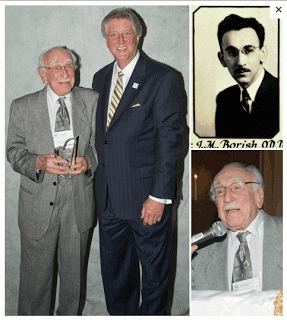Comments: Dr. Karla Zadnik spoke these words honoring ICO alumnus, Dr. Irving Borish, at his memorial service. I wish to pass them along to all reading this blog. Dr. Borish, a true giant within Optometry, always had a kind word for all and wise advice for those who would heed it. Karla suggests that if you wish to honor Dr. Borish to make a donation to the American Optometric Foundation (see below). I would also like to suggest that if you are an Illinois College of Optometry graduate, that you make a donation to ICO in his name as well. DM
(Above) Dr. Borish (left) with Dr. Arol Augsburger, President of the Illinois College of Optometry. Additional photographs of Dr. Borish (right)
I am honored to speak on behalf of the American Academy of Optometry and the American Optometric Foundation. I recently read Fellow Bill Baldwin's biography, Borish, and discovered that Irv had a near-fatal heart attack near the end of the 1972 Academy meeting in New York. He was admitted to intensive care at a New York hospital and finally went home after 10 weeks in the hospital. In typical upbeat fashion, Irv declared it "the longest Academy meeting ever!" Irv's obituary described him as a confidant of every Academy president since 1936, and I am no exception.
Irv Borish saw the future. He was actively cognizant of it. That's hard to do. We all get caught up in our day-to-day endeavors and suddenly find those days have turned to weeks, months, and years; often, we've lost sight of the future and wonder what we have to show for all those days' efforts.
Irv's significant contributions to the Academy and AOF are evidence of his focus on the future. He created the Irvin M. and Beatrice Borish Award for young scientists to encourage their progress toward their bright futures. The Borish Award-and Irv-bet on its recipients, and a quick perusal of the list of awardees shows that his investment has been returned. The AOF awards an endowed Borish Ezell fellowship annually to a promising young graduate student. The young Borish Ezells so far and the countless ones who will follow will bear his stamp of approval and must align with his view of the future.
Not surprisingly, I've heard from many young people who, hearing of Irv's passing, wanted to share their reflections on how Dr. Borish touched them. Fellow Kathy Osborn talked about having happened into the AOF Celebration Luncheon when Irv's 90th birthday was celebrated. She ended up in the empty seat next to Irv and described to me how aware she was of the significance of the event. Fellow Danne Ventura from Essilor shared a past Optometry Student Bowl "rules" video that shows Irv in a football uniform with "92" (his age) as his number, being tackled by eager optometry students from NOVA Southeastern University. Danne observed, "He would do anything for the students." Fellow Stacey Townshend wrote, "I was a young graduate in 1993 receiving recognition and a monetary award from Dr. Borish for my senior year thesis work. I remember his personal touch in a note of congratulations and thinking what a great man to support the future of optometry after having dedicated and contributing so much to its past. Such a generous person—of himself, his knowledge, his time and his kind monetary gesture to—I'm sure—hundreds of new optometrists over the years. He will be missed but certainly not forgotten."
Two days ago, we watched Irv's 2009 inaugural Myers lecture video at Ohio State. The room was full of faculty and graduate students, and the room was adorned with two of Irv's paintings. He spoke on screen for more than an hour, without notes, on the history of optometry. As we watched, we paused the video whenever someone wanted to share a story or comment on what he'd said. The speech ended—typically—with an anecdote to illustrate a point. He told a story of seeing two University of Houston optometry students after a talk he'd given to them. As they walked away, one of them turned back toward Irv and said, "Dr. Borish, we will carry on." As I looked around our conference room at Ohio State, there wasn't a dry eye in the room. Irv continued on the video, "Of course, I didn't know the students' names, so I never checked back with them to see if they did indeed carry on."
Dr. Irvin Borish won't be around now to see if the optometric profession and its leaders carry on, but we must. The young scientists and graduate students his name rewards in the future will carry on. Future Academy presidents should pretend they're consulting with Irv as they lead. The AOF will build on his legacy. Rest easy and assured, Irv, we will carry on.
If you would like to contribute to programs that were dear to Dr. Borish, please donate to the American Optometric Foundation.
Dr. Karla Zadnik, President, American Academy of Optometry
